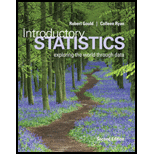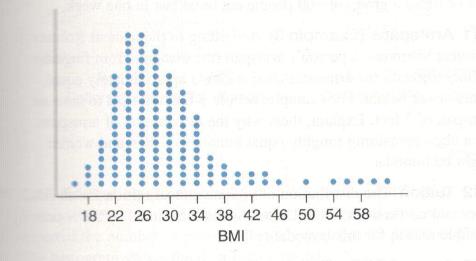
Concept explainers
Body Mass Index The Dotplot shows body mass index r (BMI) for 134 people according to the National Health and Nutrition Examination Survey (NHANES) in 2010, as reported in U.S.A Today.
a. A B U or more than 40 is considered morbidly obese. Report the number of morbidly obese
shown in the dotplot.
b. report the percentage of people who are morbidly obese. Compare this with an estimate from
2005 that 3% of people in the United Stated as that time were morbidly obese.

a.
Determine the number of morbidly obese people from the dot plot.
Answer to Problem 1SE
The number of morbidly obese people is
Explanation of Solution
According to the provided details, a person is considered to be morbidly obese if the Body Mass Index (BMI) of a person is above
The number of people having the Body Mass Index (BMI) above
b.
Determine the percentage of people who are morbidly obese in
Answer to Problem 1SE
The percentage of people who are morbidly obese in
Explanation of Solution
The provided details show that, in
From the dot-plot that provides the data of the U.S. for the year 2010, the number of people who were morbidly obese is
The percentage of people who are morbidly obese can be calculated as:
Therefore, the required percentage is
This indicates that there is an increase in the percentage of people who were morbidly obese in 2010, as the percentage has increased from
Want to see more full solutions like this?
Chapter 2 Solutions
Introductory Statistics (2nd Edition)
- A marketing agency wants to determine whether different advertising platforms generate significantly different levels of customer engagement. The agency measures the average number of daily clicks on ads for three platforms: Social Media, Search Engines, and Email Campaigns. The agency collects data on daily clicks for each platform over a 10-day period and wants to test whether there is a statistically significant difference in the mean number of daily clicks among these platforms. Conduct ANOVA test. You can provide your answer by inserting a text box and the answer must include: also please provide a step by on getting the answers in excel Null hypothesis, Alternative hypothesis, Show answer (output table/summary table), and Conclusion based on the P value.arrow_forwardA company found that the daily sales revenue of its flagship product follows a normal distribution with a mean of $4500 and a standard deviation of $450. The company defines a "high-sales day" that is, any day with sales exceeding $4800. please provide a step by step on how to get the answers Q: What percentage of days can the company expect to have "high-sales days" or sales greater than $4800? Q: What is the sales revenue threshold for the bottom 10% of days? (please note that 10% refers to the probability/area under bell curve towards the lower tail of bell curve) Provide answers in the yellow cellsarrow_forwardBusiness Discussarrow_forward
- The following data represent total ventilation measured in liters of air per minute per square meter of body area for two independent (and randomly chosen) samples. Analyze these data using the appropriate non-parametric hypothesis testarrow_forwardeach column represents before & after measurements on the same individual. Analyze with the appropriate non-parametric hypothesis test for a paired design.arrow_forwardShould you be confident in applying your regression equation to estimate the heart rate of a python at 35°C? Why or why not?arrow_forward
 Glencoe Algebra 1, Student Edition, 9780079039897...AlgebraISBN:9780079039897Author:CarterPublisher:McGraw Hill
Glencoe Algebra 1, Student Edition, 9780079039897...AlgebraISBN:9780079039897Author:CarterPublisher:McGraw Hill Holt Mcdougal Larson Pre-algebra: Student Edition...AlgebraISBN:9780547587776Author:HOLT MCDOUGALPublisher:HOLT MCDOUGAL
Holt Mcdougal Larson Pre-algebra: Student Edition...AlgebraISBN:9780547587776Author:HOLT MCDOUGALPublisher:HOLT MCDOUGAL Big Ideas Math A Bridge To Success Algebra 1: Stu...AlgebraISBN:9781680331141Author:HOUGHTON MIFFLIN HARCOURTPublisher:Houghton Mifflin Harcourt
Big Ideas Math A Bridge To Success Algebra 1: Stu...AlgebraISBN:9781680331141Author:HOUGHTON MIFFLIN HARCOURTPublisher:Houghton Mifflin Harcourt College Algebra (MindTap Course List)AlgebraISBN:9781305652231Author:R. David Gustafson, Jeff HughesPublisher:Cengage Learning
College Algebra (MindTap Course List)AlgebraISBN:9781305652231Author:R. David Gustafson, Jeff HughesPublisher:Cengage Learning



